AUDI R8 SPYDER 2015 Manual Online
Manufacturer: AUDI, Model Year: 2015, Model line: R8 SPYDER, Model: AUDI R8 SPYDER 2015Pages: 232, PDF Size: 58.36 MB
Page 81 of 232
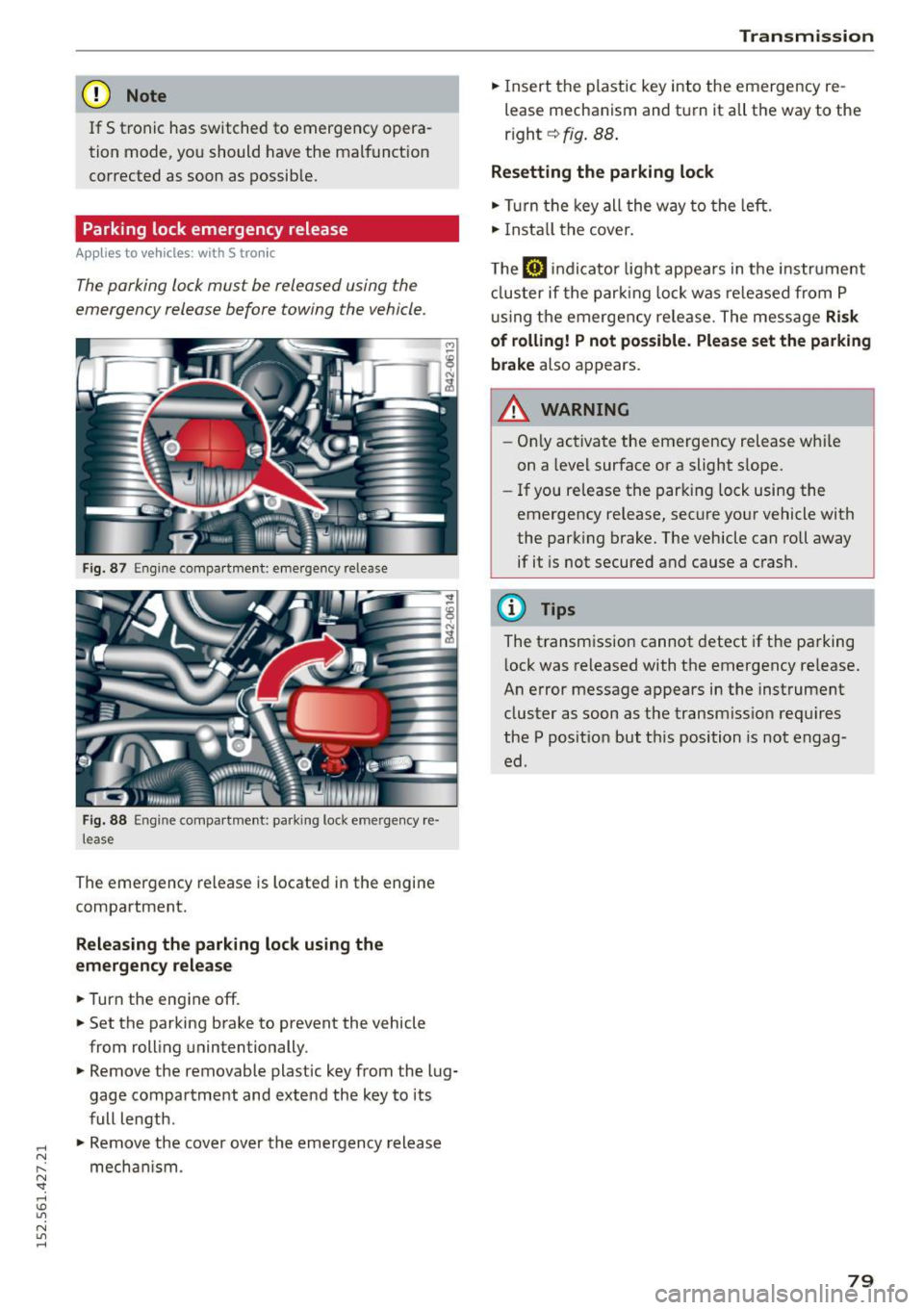
.... N
l'
N "1: .... I.O
"' N
"' ....
(D Note
If S tronic has switched to emergency opera
tion mode, you should have the malfunction corrected as soon as possible.
Parking lock emergency release
App lies to vehicles: with S tro nic
The parking lock must be released using the
emergency release before towing the vehicle.
F ig. 87 Engine compart men t: emergency release
Fig. 88 Engine compa rtment: parking lock emergency re·
lease
The emergency release is located in the engine
compartment.
Releasing the parking lock using the
emergency release
.,. Turn the engine off .
.,. Set the parking brake to prevent the vehicle
from rolling unintentionally .
.,. Remove the removable plastic key from the lug
gage compartment and extend the key to its
full length .
.,. Remove the cover over the emergency release
mechan ism .
Tran smission
.,. Insert the plastic key into the emergency re
lease mechanism and turn it all the way to the
r ight ~
fig. 88.
Resetting the parking lock
.,. Turn the key all the way to the left.
.,. Install the cover.
The
[il indicator light appears in the instrument
cluster if the parking lock was released from
P
using the emergency release. The message Risk
of rolling! P not possible. Please set the parking
brake
also appears.
,&_ WARNING
- Only activate the emergency release whi le
on a level surface or a slight s lope.
- If you release the parking lock using the
emergency release, secure your vehicle with
the parking brake. The vehicle can roll away if it is not secured and cause a crash.
(D Tips
The transmission cannot detect if the parking
l ock was released with the emergency re lease.
An error message appears in the instrument
cluster as soon as the transmiss ion requires
the
P position but th is position is not engag
ed.
79
Page 82 of 232
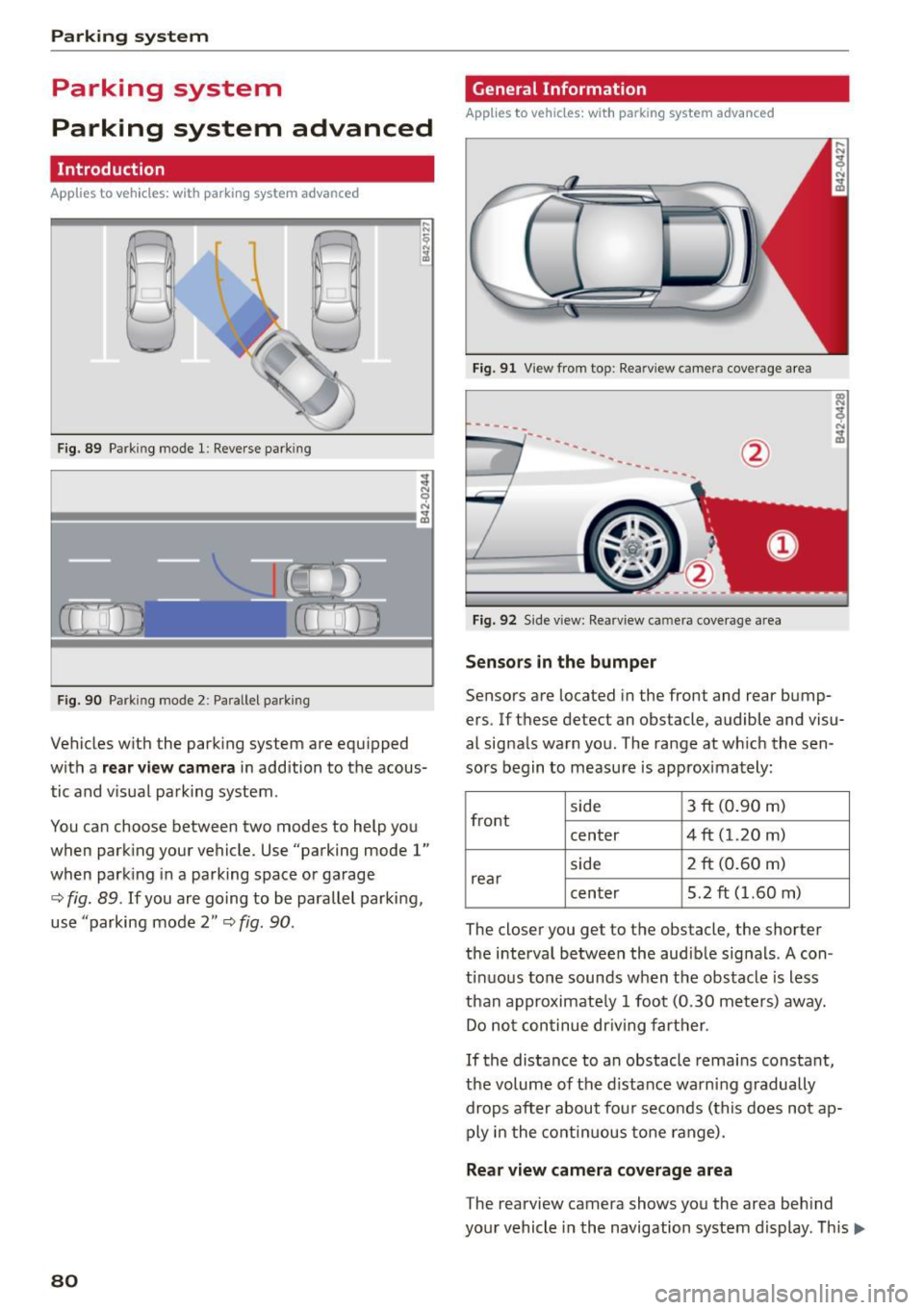
Parking system
Parking system
Parking system advanced
Introduction
Applies to vehicles: with park ing system advanced
Ll
I
Fig. 89 Parking mode 1: Reverse park ing
F ig. 90 Parking mode 2: Parallel parking
Ll
I
Vehicles with the parking system are equ ipped
with a
rear view camera in addition to the acous
tic and visual parking system.
You can choose between two modes to help you
when parking your vehicle. Use "parking mode 1"
when parking in a parking space or garage
c:;, fig. 89. If you are going to be parallel parking,
use "parki ng mode 2"
r=;,fig. 90.
80
General Information
Applies to vehicles: with parking system advanced
Fig. 91 View from top: Rearview camera coverage area
-------.. -..
Fig. 92 Side view: Rearv iew camera cove rage area
Sensors in the bumper
Sensors are located in the front and rear bump
ers. If these detect an obstacle, audible and visu
al signals warn you . The range at wh ich the sen
sors begin to measure is approximately:
side 3 ft (0.90 m)
front center 4 ft (1.20 m)
side 2
ft (0.60 m)
rear center 5 .2 ft (1.60 m)
The closer you get to the obstacle, the shorter
the interval between the audible signals . A con
tinuous tone sounds when the obstacle is less
than approximately 1 foot (0 .30 meters) away.
Do not continue dr iving farther.
If the distance to an obstacle remains constant,
the volume of the distance warning gradually
drops after about four seconds (this does not ap
ply in the continuous tone range).
Rear view camera coverage area
The rearview camera shows you the area beh ind
your vehicle in the navigation system display. This..,_
Page 83 of 232
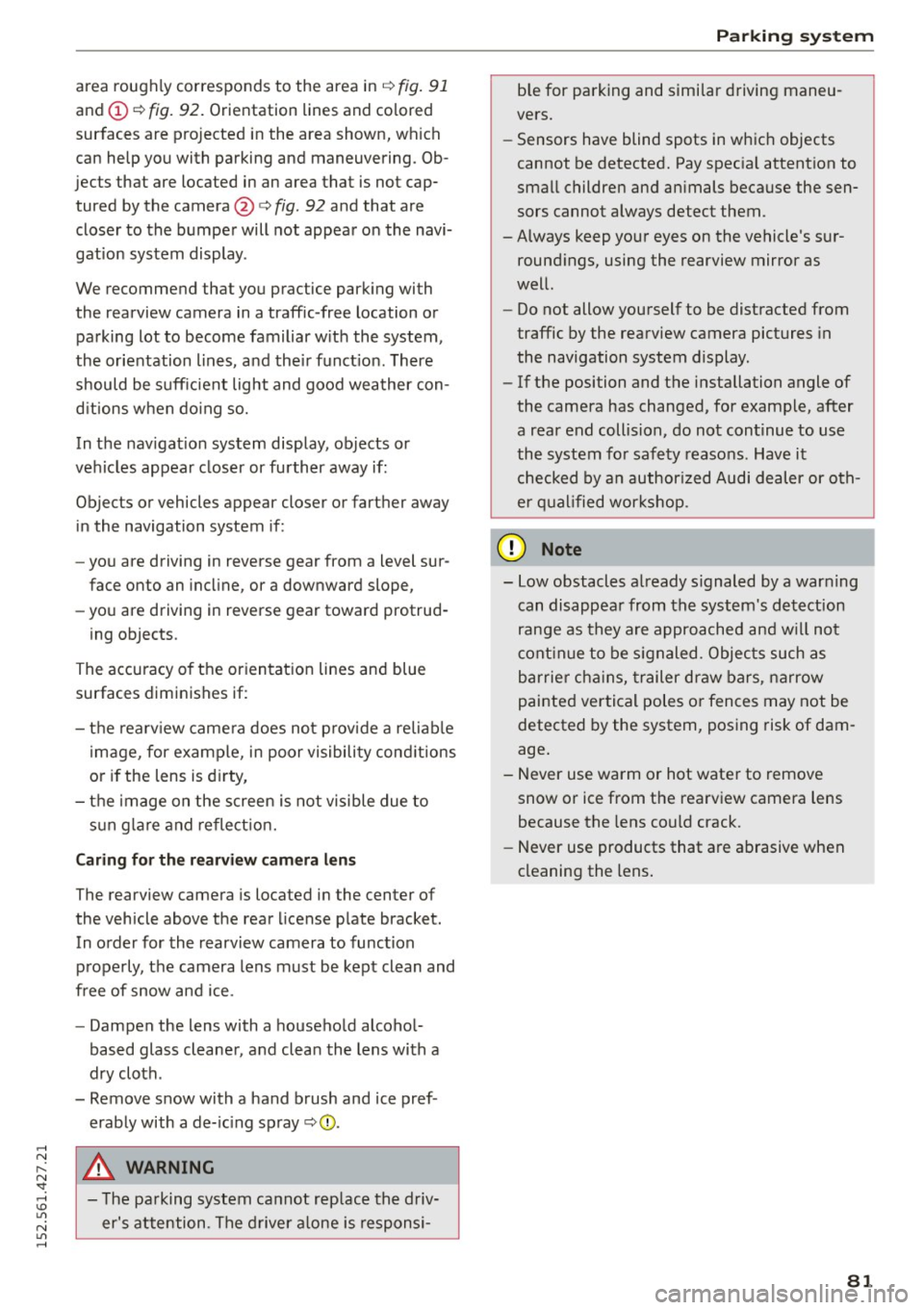
..... N
r-N "': ..... \!) 1.1'1
N 1.1'1 .....
area roughly corresponds to the area in¢ fig. 91
and (D ~ fig . 92. Orientation lines and colored
surfaces are projected in the area shown, which
can help you with parking and maneuvering. Ob
jec ts that are located in an area that is not cap
tured by the camera@¢
fig. 92 and that are
closer to the bumper will not appea r on the navi
gation system display .
We recommend that you practice park ing with
the rearview camera in a traffic -free location o r
parking lot to become familiar w ith the system,
the orientation lines, a nd their funct ion . There
should be suff icient light and good weather con
d itions w hen do ing so.
In the nav igat io n system display, objects or
vehicles appear closer or fu rther away if:
Objects or vehicles appear closer or farther away in the navigation system if :
- you are driving in reverse gear from a level sur
face onto an incl ine, or a downward slope,
- you are driving in reverse gear toward protrud-
ing objects .
The accuracy o f the orientation lines and blue
surfaces diminishes if:
- the rearv iew came ra does not p rovide a reliab le
image, for example, in poor visibility cond itions
or if the lens is d irty,
- the image on the screen is not visible due to
s u n g lare and reflect ion.
Caring for th e rearvi ew cam era len s
The rearview camera is located in the center of
the vehicle above the rear license p late bracket.
In order for the rearview camera to function
p roperly, the camera lens must be kept clean and
free of snow and ice .
- Dampen the lens with a househo ld alcoho l
based glass cleane r, and clea n the lens with a
dry cloth .
- Remove snow with a hand brush and ice pref
erably with a de- ic ing spray ¢(j) .
A WARNING
- T he pa rking system cannot rep lace the d riv
er' s a ttention . The d rive r alone is responsi-
P a rk ing system
ble for parking and simi lar d riving maneu
vers.
- Sensors have blind spots in whic h objects
cannot be detected. Pay spec ia l attention to
small children and an imals beca use the sen
sors cannot always detect them.
- Always keep your eyes on the vehicle 's sur
round ings, using the rearview mirror as
well.
- Do not allow yourself to be distracted from
traffic by the rearview camera pictures in
the navigation system display .
-If the position and the installation angle of
the camera has changed, for example, after
a rear end collision, do not continue to use
the system fo r safety reasons . Have it
checked by a n author ized Audi dealer or oth
er q ua lif ied wor kshop .
(!) Note
-Low obstacles a lready s ignaled by a war ning
can disappea r from the system 's detection
range as they a re approached and w ill not
cont in ue to be s ignaled . Objec ts such as
barrie r cha ins, trailer draw ba rs, narrow
painted vertical poles o r fences may not be
detected by the system, pos ing risk of dam
age .
- Never use warm or hot wate r to remove
snow or ice from the rearv iew camera lens
because the lens could crack .
- Never use products that a re abrasive when
cleaning the lens .
81
Page 84 of 232
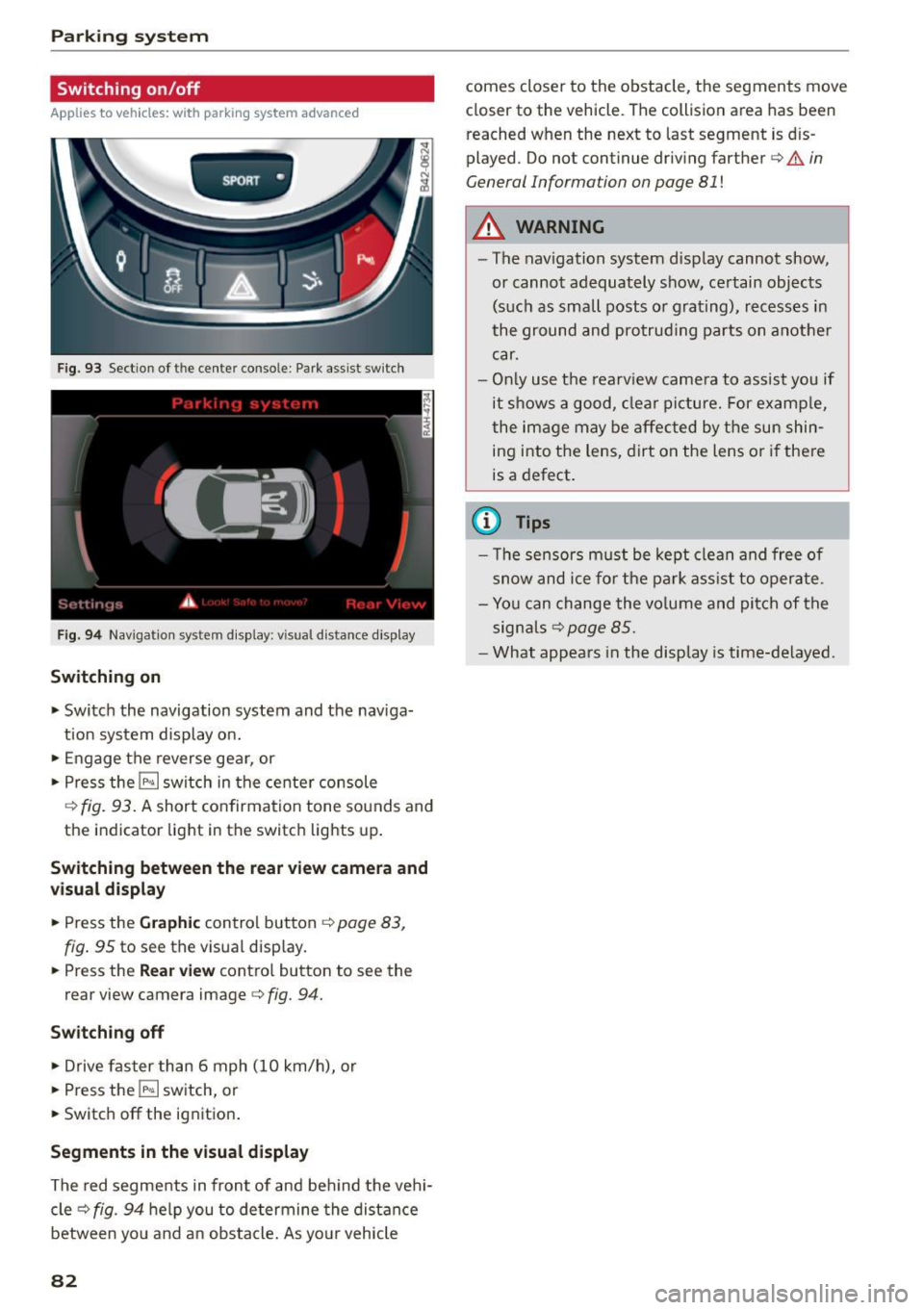
Parking syste m
Switching on /off
App lies to veh icles: w ith park ing system advanced
SPORT •
Fig. 93 Section of the cente r conso l-e : Park ass ist sw itch
F ig . 94 Naviga tio n sys tem display : v isual distance display
Sw itching on
... Switch the navigation system and the nav iga
tion system display o n .
... Engage the reverse gea r, or
... Press the
!l¾ I switch in the center console
Q fig. 93. A short confirmation tone sounds and
the indicator light in the switch lights up.
Switching betwe en th e rear view c amera and
vi su al d isplay
... Press the Graphic control button ¢ page 83,
fig . 95
to see the visual disp lay .
... Press the
Rea r v iew contro l button to see the
rear view camera image¢
fig. 94.
Switch ing off
... Drive faster than 6 mph (10 km/h), or
... Press the
!P-<. I switch, or
... Switc h off the ignition .
Segments in the visual d isplay
The red segments in front of and be hind the vehi
cle¢
fig. 94 help you to determine the distance
between you and a n obstacle. As your vehicle
82
comes closer to the obstacle, the segments move
closer to the vehicle . The collision area has been
reached when the next to last segment is dis
played. Do not continue driving farther
Q & in
General Information on page 81
!
A WARNING
-The navigation system display cannot show,
or cannot adequately show, certain objects (such as small posts or grating), recesses in
the ground and protrud ing parts on another
car.
- Only use the rearv iew camera to assist you if
it s hows a good, clear pictu re. For examp le,
the image may be affected by t he sun shin
ing i nto the lens, dirt oh the lens or if there
is a defect .
(1) Tips
- The sensors m ust be kept clean and free of
snow and ice for the park ass ist to operate.
- Yo u can change the vo lume and pit ch of the
signa ls
Qpage 85.
-What appears in the display is time-delayed.
Page 85 of 232
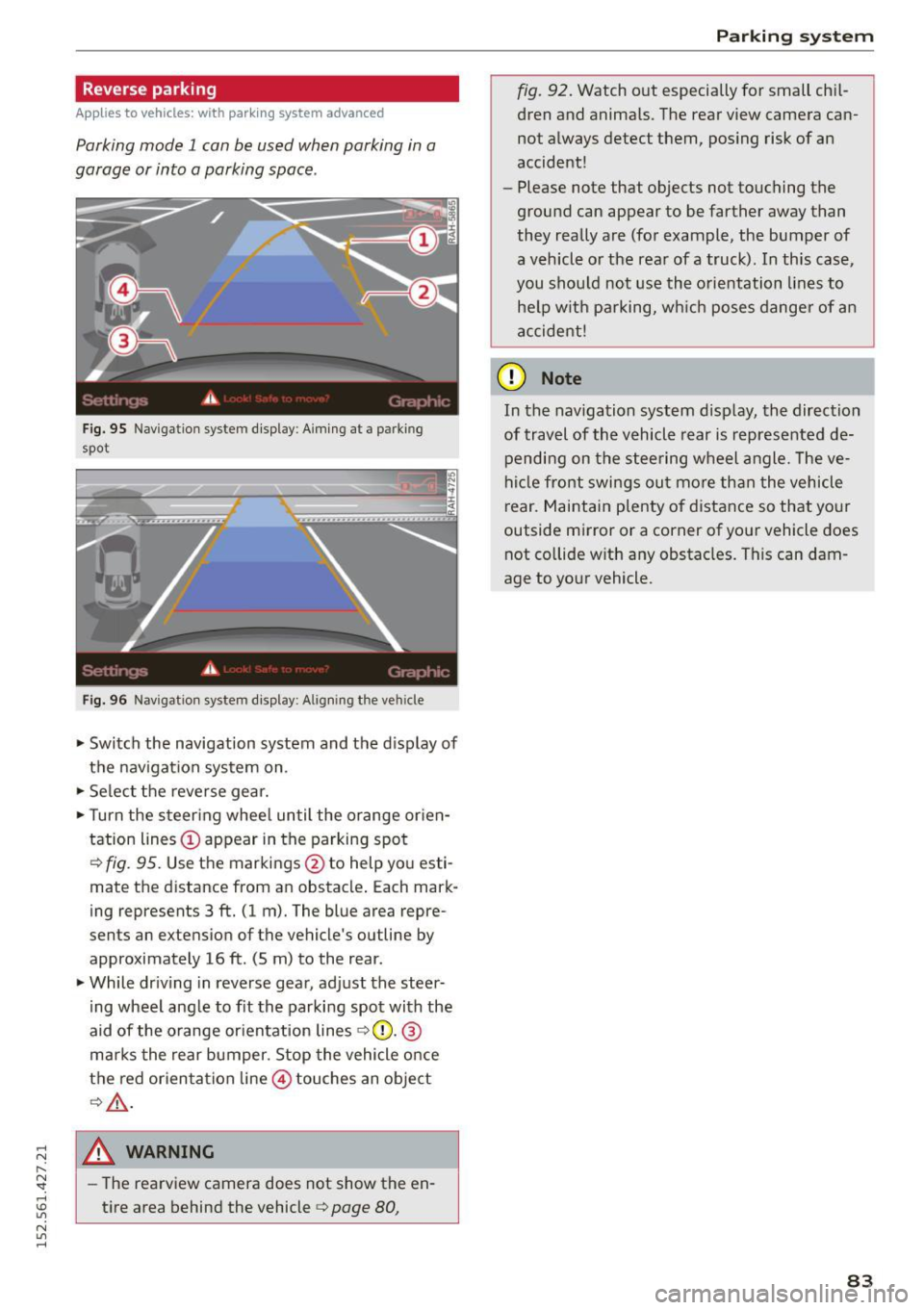
.... N
l'
N "1: .... I.O
"' N
"' ....
Reverse parking
Applies to vehicles: with parking system advanced
Parking mode 1 can be used when parking in a
garage or into a parking space .
Fig. 95 Navigation system display : Aiming at a p arkin g
spot
Fig. 96 Naviga tion sy ste m display: Al ig ni ng t he ve hicle
"'Switch the navigation system and the display of
the navigation system on.
"'Select the reverse gear.
"'Turn the steering wheel until the orange orien
tation lines(!) appear in the parking spot
c> fig. 95. Use the markings @to help you esti
mate the distance from an obstacle. Each mark
ing represents 3
ft. (1 m). The blue area repre
sents an extension of the vehicle's outline by
approximately 16
ft. (5 m) to the rear .
"'While driving in reverse gear, adjust the steer
ing wheel angle to fit the parking spot with the
aid of the orange orientation lines
c> 0 . ®
marks the rear bumper. Stop the vehicle once
the red orientation line@ touches an object
¢&, .
_& WARNING
-The rearview camera does not show the en
tire area behind the vehicle
c> page 80,
Parking system
fig. 92. Watch out especially for small chil
dren and animals. The rear view camera can
not always detect them, posing risk of an
accident!
- Please note that objects not touching the
ground can appear to be farther away than
they really are (for example, the bumper of
a vehicle or the rear of a truck). In this case,
you should not use the orientation lines to
help with parking, which poses danger of an
accident!
(D Note
In the navigation system display, the direction
of travel of the vehicle rear is represented de pending on the steering wheel angle. The ve
hicle front swings out more than the vehicle
rear. Maintain plenty of distance so that your
outside mirror or a corner of your vehicle does
not collide with any obstacles. This can dam
age to your vehicle.
83
Page 86 of 232
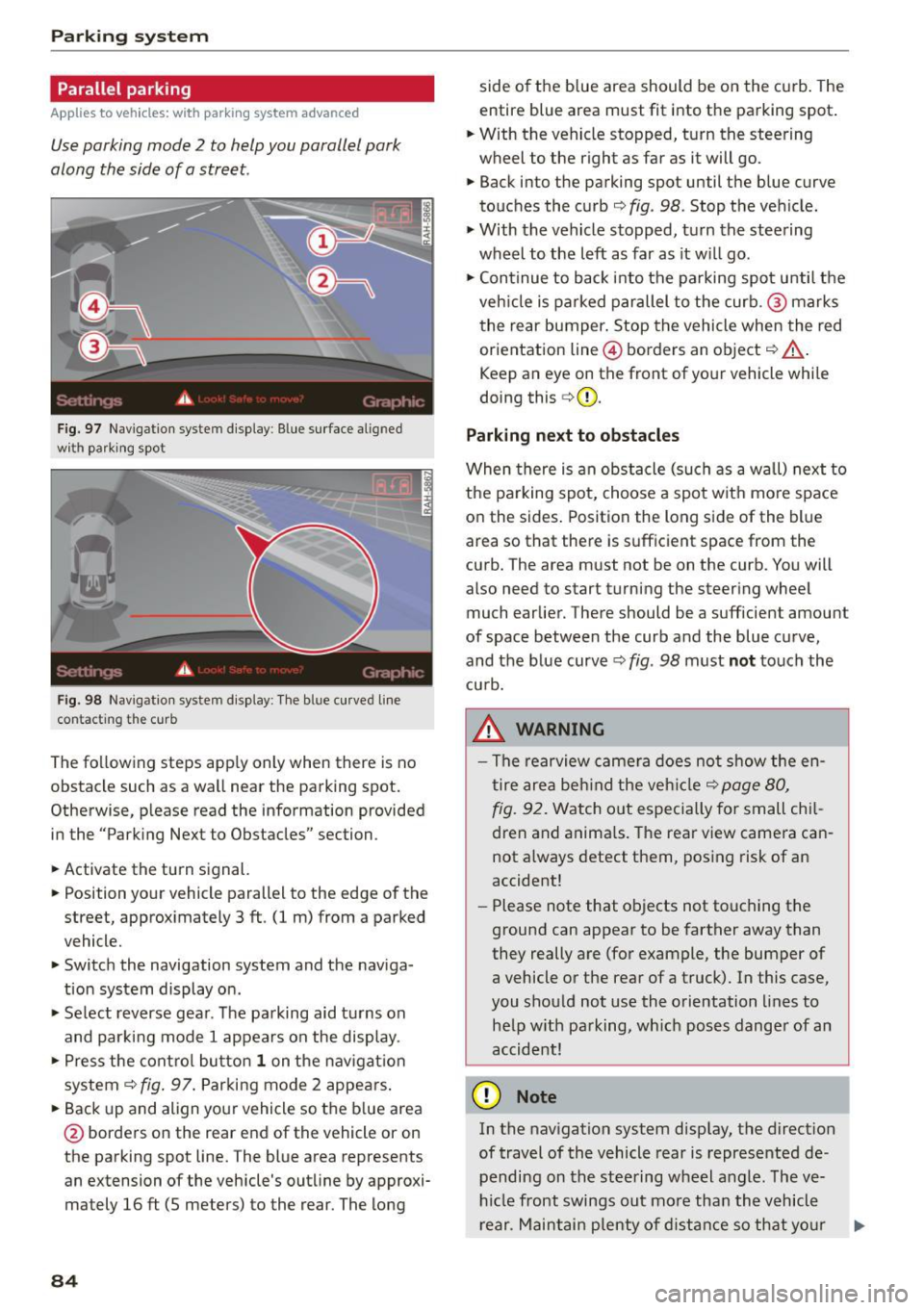
Parking system
Parallel parking
Applies to vehicles: with parking system advanced
Use parking mode 2 to help you parallel park
along the side of a street.
Fig . 97 Na vigation system d isplay : Blue sur face aligned
wit h parking spot
0
-
Fig. 98 Navigatio n system display: The blue cu rved line
contacting the curb
The following steps app ly only when there is no
obstacle such as a wall near the parking spot.
Otherwise, please read the information provided
in the "Parking Next to Obstacles" section .
• Activate the turn signal.
• Position your vehicle parallel to the edge of the
street, approximately 3 ft . (1 m) from a parked
vehicle.
" Switch the navigation system and the naviga
tion system display on .
• Se lect reverse gear. The parking aid t urns on
and parki ng mode 1 appears on the display.
• Press the control button
1 on the navigat ion
system
9fig . 97. Parking mode 2 appears.
•B ackup and align your vehicle so the blue area
@ borde rs on the rear end of the vehicle or on
the parking spot line. The blue area represents
an extension of the vehicle's outline by approxi
mately 16 ft (5 meters) to the rear. The long
84
side o f the b lue area should be on the curb . The
entire blue area must fit into the parking spot .
"W ith the vehicle stopped, turn the steering
wheel to the right as far as it will go.
• Back into the parking spot until the blue curve
touches the curb
9 fig . 98. Stop the veh icle .
" With the vehicle stopped, turn the steering
wheel to the left as far as it wi ll go .
• Con tinue to back into the parking spot until the
veh icle is parked parallel to the curb .@ marks
the rear bumper. Stop the vehicle when the red
orientation line@ borders an object
9 ,&.
Keep an eye on the front of yo ur vehicle while
doing this
c> (D.
Parking next to obstacles
When there is an obstacle (such as a wall) next to
the parking spot, choose a spot with more space
on the sides . Position the long side of the blue
area so that there is sufficient space from the
curb. The area must not be on the curb . You will
also need to start turning the steering wheel
much earlier. There should be a sufficient amoun t
of space between the curb and the blue curve,
and the blue curve¢
fig. 98 must not touch the
cu rb.
_& WARNING
- The rearview camera does not show the en
tire area behind the vehicle
c> page 80,
fig .
92. Watch out especially for small chil
dren and animals. Th e rear view camera can
not a lways detect them, posing risk of an
accident!
- Please note that objects not touching the
ground can appear to be farther away than
they really are (for example, the bumper of
a vehicle or the rear of a truck). In this case,
you should not use the orientation lines to
he lp with parking, wh ich poses danger of an
accident!
(D Note
In the navigation system disp lay, the direction
of travel of the vehicle rear is represented de
pending on the steering wheel angle. The ve
hicl e front swings out more than the vehicle
rear . Maintain plenty of distance so that your
lllJ,,
Page 87 of 232
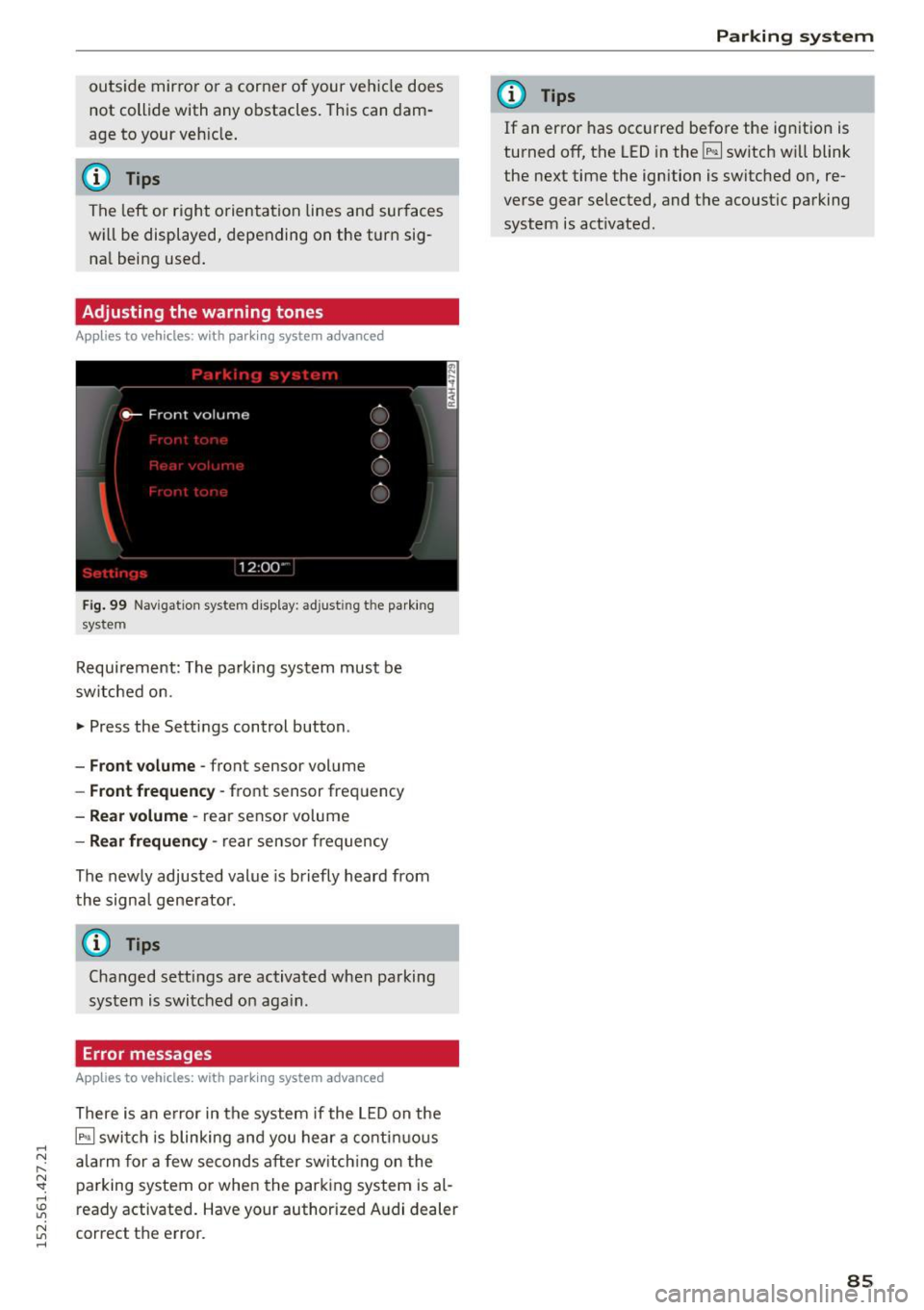
.... N
l'
N "1: .... I.O
"' N
"' ....
outside mirror or a corner of your veh icle does
not collide with any obstacles . This can dam
age to your veh icle .
@ Tips
The left or right orientation lines and surfaces
w ill be displayed , depending on the turn sig
na l being used .
Adjusting the warning tones
Applies to vehicles: with pa rking system advanced
Fig . 9 9 Nav igatio n system d isp lay: adjusting th e park ing
system
Requi rement: The parking system must be
switched on.
• Press the Settings control button .
-Front volume -front sensor volume
-Front frequency -front sensor frequency
- Rear volume -rear sensor volume
-Rear frequen cy -rear sensor frequency
The newly adjusted value is briefly heard from
the signa l gene rator.
0) Tips
Changed settings are activated when parking
system is switched on aga in .
Error messages
Applies to vehicles: with park ing system advanced
There is an e rror in the system if the L ED on the
~ switch is blinking and you he ar a co nti nu ous
ala rm for a few seconds a fter sw itch ing on the
pa rking system or when the park ing system is al
ready activated . Have your authorized A udi dealer
correct the e rror.
Par king system
(D Tips
If an error has occ urre d before the ignition is
turned off, the LED in the ~ switch wi ll blink
the next time the ignition is switc hed on, re
verse gear selected, and t he acoustic pa rking
system is act ivated .
85
Page 88 of 232
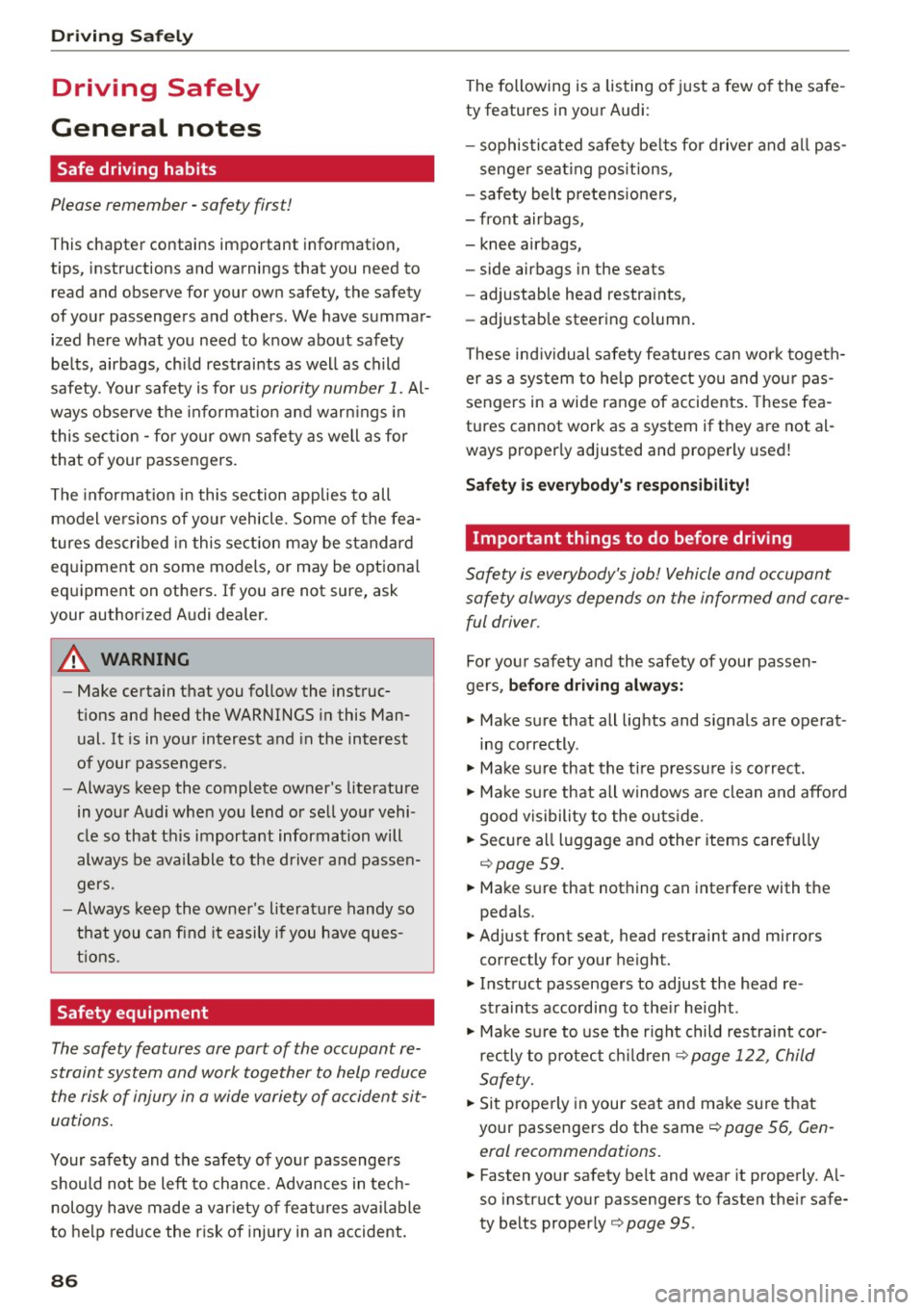
Driving Sa fel y
Driving Safely
General notes
Safe driving habits
Please remember -safety first!
This chapter contains important information,
tips, instructions and warnings that you need to
read and observe for your own safety, the safety
of your passengers and others. We have summar
ized here what you need to know about safety
be lts, airbags, chi ld restraints as well as child
safety. Your safety is for us
priority number 1 . Al
ways observe the informat ion and warn ings in
t his section - for your own safety as well as for
that of your passengers.
The information i n this section applies to all
model ve rsions of your vehicle . Some of the fea
t ures des cribed in this sect ion may be standard
equipment on some models, or may be optional
eq uipment on others . If you are not sure, ask
your author ized Audi dealer.
A WARNING
-Make certain that you fo llow the instruc
t ions and heed the WARNINGS in this Man
ual. It is in your interest and in the interest
of your passengers .
- Always keep the complete owner's literature
in your Audi when you lend or se ll you r vehi
cle so that this important information will
always be ava ilable to the driver and passen
gers.
- Always keep the owner's literature handy so
that you can find it easily if you have ques
ti ons.
Safety equipment
The safety features are part of the occupant re
straint system and work together to help reduce
the risk of injury in a wide variety of occident si t
uations.
Your safety and the safety of yo ur passengers
should not be left to chance. Advances in tec h
nology have made a var iety of f eatures av ailable
to help re duce the r isk of inj ury in an accident.
86
The following is a listing o f just a few o f the safe
ty features in yo ur Audi:
- sophis tica ted s afety be lts for drive r and a ll pas-
senger sea ting pos itions,
- safety belt p rete nsio ners,
- front airbags,
- knee airbags,
- side airbags in the seats
- adjustab le head restraints,
- adjustab le steering column .
These ind iv idual safety featu res can wor k togeth
er as a sys tem to he lp pro tect you a nd your pas
sengers in a wide range of accidents . These fea
tures cannot work as a system if th ey are not al
ways proper ly adjusted and prope rly used!
Safety i s everyb ody' s re sponsibilit y!
Important things to do before driving
Safety is everybody's job! Vehicle and occupant
safety always depends on the informed and care
ful driver.
Fo r you r safety and the safety of your passen
gers,
before driving always:
.,. Make sure that all lights and signals are operat
ing correctly .
.,. Make sure that the tire pressu re is co rrect.
.,. Ma ke s ure that all w indows are clean and affo rd
good visibility to the outs ide.
.,. Secure a ll luggage and o ther items caref ully
r=;,page 59 .
.,. Make s ure that nothing can interfere with the
pedals.
.,. Adjust front seat, head restraint and mirrors
correctly for your height.
.,. Instruct passengers to adjust the head re
straints according to the ir height .
.,. Make su re to use the r ight child restraint cor
rec tly to p rotect ch ild ren
r=;, page 122, Child
Safety.
.,. Sit p roperly in your seat and ma ke su re that
your passengers do the same
c::> page 56, Gen
eral recommendations.
.,. Fasten your safety belt and wear it properly. A l
so instruct your passengers to fasten their safe
ty belts proper ly
c::> page 95 .
Page 89 of 232
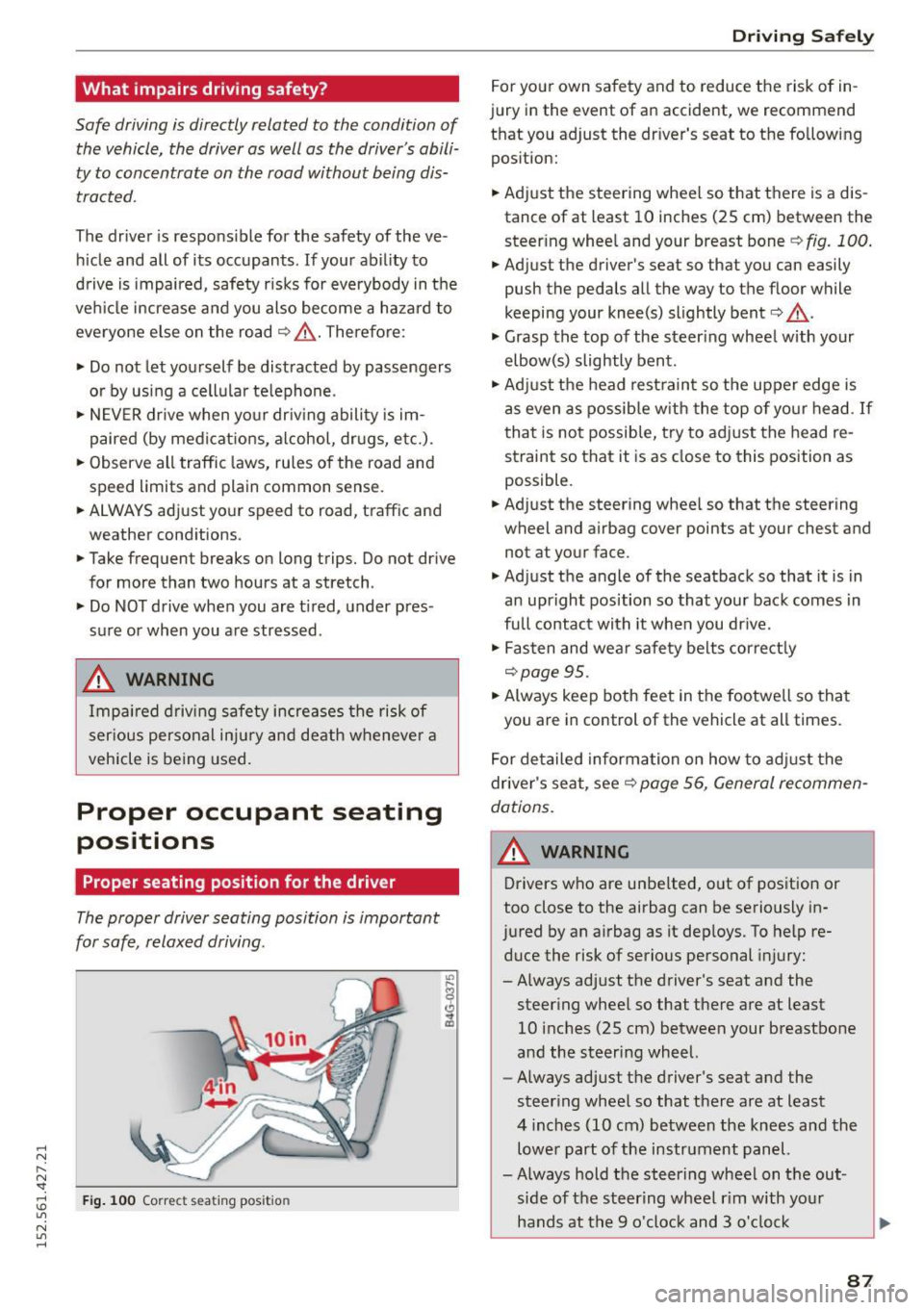
.... N
l'
N "1: .... I.O
"' N
"' ....
What impairs driving safety?
Safe driving is directly related to the condition of
the vehicle, the driver as well as the driver's abili
ty to concentrate on the road without being dis
tracted.
The driver is respons ible for the safety of the ve
h icle and all of its occupants . If your ability to
d rive is impaired, safety r isks for everybody in the
ve hicle increase and you also become a hazard to
everyone else on the road ¢A -Therefore:
• Do not let yourself be distracted by passengers
or by us ing a cell ular te lephone.
• NEV ER dr ive when your dr iv ing ability is im
paired (by medicat ions, alcohol, dr ugs, e tc.).
• Observe all traffic laws, ru les of the road and
speed limits and plain common sense.
• ALWAYS ad just your speed to road, traffic and
weather conditions.
• Take frequent breaks on long trips. Do not drive
for more than two hours at a stretch .
• Do NOT drive when you are t ired, under pres
sure or when you are stressed .
A WARNING
Impaired driving safety increases the risk of
ser ious personal in ju ry and death whenever a
vehicle is being used.
Proper occupant seating
positions
Proper seating position for the driver
The proper driver seating position is important
for safe, relaxed driving.
F ig. 10 0 Correct seating position
.
Driving S afely
For yo ur own sa fety and to reduce the risk of in
jury in the event of an accident, we recommend
that you adjust the dr iver's seat to the following
pos ition:
• Adjust the steering wheel so that there is a dis
tance of at least 10 inches (25 cm) between the
steer ing whee l and your breast bone
¢ fig. 100 .
• Adjust the driver's seat so that you can easily
push the pedals all the way to the floor while
keeping your knee(s) slightly bent<=>
A .
• Grasp the top of the steer ing whee l with your
elbow(s) slightly bent .
• Adjust the head rest rain t so the upper edge is
as even as possib le w it h t he top of yo ur head.
If
that is no t possib le, try to ad just the head re
straint so that it is as close to this pos ition as
possible .
• Adjust the steering wheel so that the steering
wheel and airbag cover points at your chest and
not at your face .
• Adjust the angle of the seatback so that it is in
an upr ight position so that you r bac k comes in
full contact with it when you dr ive.
• Fas ten and wear safe ty belts corre ct ly
<=>page 95.
• Always keep both feet in the footwe ll so that
you are in control of the vehicle at all times.
For detailed inform ation on how to adj ust the
driver's seat, see¢
page 56, General recommen
dations.
A WARNING
-Drivers who are unbelted, o ut of position or
too close to the airbag can be seriously in
jured by an airbag as it dep loys. To help re
duce the risk of serious personal injury:
- Always adj ust the driver 's seat and the
steer ing whee l so that there are at least
10 i nches (25 cm) between your breastbo ne
and the steering wheel.
- Always adjust the driver 's seat and the
steer ing whee l so that there are at least
4 inches (10 cm) between the knees and the
lowe r part of the instrument panel.
- Always hold the steering wheel on t he out
side of the steer ing wheel r im with yo ur
hands at the 9 o 'clock and 3 o'clock
87
Page 90 of 232
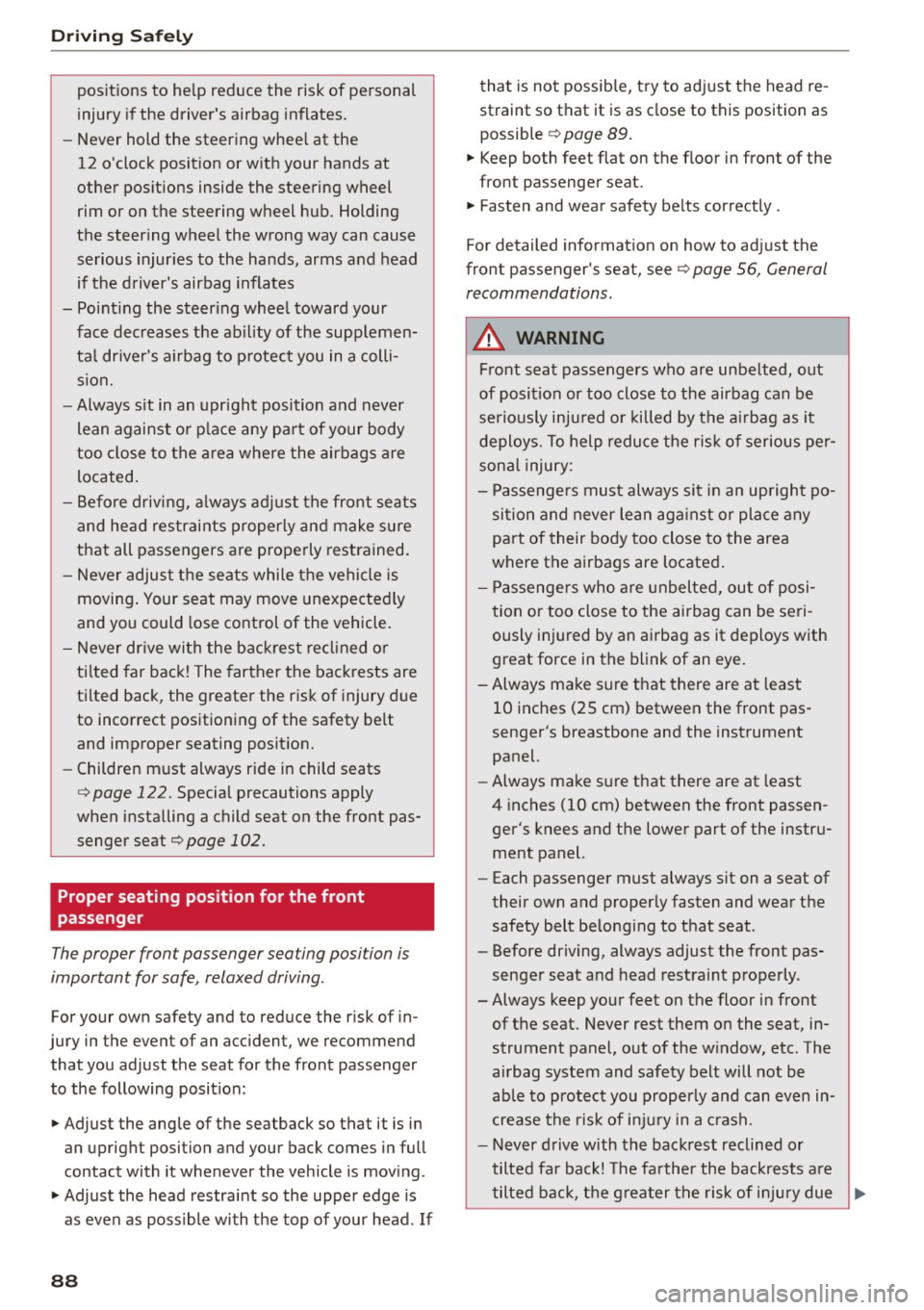
Driving Safely
positions to help reduce the risk of personal
injury if the driver's airbag inflates.
- Never hold the steering wheel at the
12 o'clock position or with your hands at
other positions inside the steering wheel
rim or on the steering wheel hub. Holding
the steering wheel the wrong way can cause
serious injuries to the hands, arms and head
if the driver's airbag inflates
- Pointing the steering wheel toward your
face decreases the ability of the supplemen
tal driver's airbag to protect you in a colli
sion.
-Always sit in an upright position and never
lean against or place any part of your body
too close to the area where the airbags are
located.
- Before driving, always adjust the front seats
and head restraints properly and make sure
that all passengers are properly restrained.
- Never adjust the seats while the vehicle is
moving. Your seat may move unexpectedly
and you could lose control of the vehicle.
- Never drive with the backrest reclined or
tilted far back! The farther the backrests are
tilted back, the greater the risk of injury due
to incorrect positioning of the safety belt and improper seating position.
- Children must always ride in child seats
¢page 122. Special precautions apply
when installing a child seat on the front pas
senger seat
¢page 102.
Proper seating position for the front
passenger
The proper front passenger seating position is
important for safe, relaxed driving .
For your own safety and to reduce the risk of in
jury in the event of an accident, we recommend
that you adjust the seat for the front passenger
to the following position:
.. Adjust the angle of the seatback so that it is in
an upr ight position and your back comes in full
contact with it whenever the vehicle is moving .
.,. Adjust the head restraint so the upper edge is
as even as possible with the top of your head. If
88
that is not possible, try to adjust the head re
straint so that it is as close to this position as
possible
¢ page 89.
.. Keep both feet flat on the floor in front of the
front passenger seat.
.. Fasten and wear safety belts correctly .
For detailed information on how to adjust the
front passenger's seat, see
¢ page 56, General
recommendations.
A WARNING
Front seat passengers who are unbelted, out
of position or too close to the airbag can be
seriously injured or killed by the airbag as it
deploys. To help reduce the risk of serious per
sonal injury:
- Passengers must always sit in an upright po
sition and never lean against or place any
part of their body too close to the area
where the airbags are located.
- Passengers who are unbelted, out of posi
tion or too close to the airbag can be seri
ously injured by an airbag as it deploys with
great force in the blink of an eye.
-Always make sure that there are at least 10 inches (25 cm) between the front pas
senger's breastbone and the instrument panel.
- Always make sure that there are at least
4 inches (10 cm) between the front passen
ger's knees and the lower part of the instru ment panel.
- Each passenger must always sit on a seat of
their own and properly fasten and wear the
safety belt belonging to that seat.
- Before driving, always adjust the front pas
senger seat and head restraint properly.
- Always keep your feet on the floor in front
of the seat. Never rest them on the seat, in
strument panel, out of the window, etc. The
airbag system and safety belt will not be
able to protect you properly and can even in
crease the risk of injury in a crash .
- Never drive with the backrest reclined or
tilted far back! The farther the backrests are
tilted back, the greater the risk of injury due
~